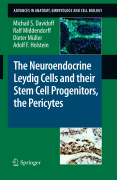
The neuroendocrine leydig cells and their stem cell progenitors, the pericytes
Davidoff, M.S.
Middendorff, R.
Muller, D.
Holstein, A.
The discovery of the neuroendocrine features of Leydig cells gave rise to thehypothesis of a potential neuroectodermal and/or neural crest origin of testicular Leydig cells. In an experimental animal model the authors revealed that adult Leydig cells originate by transdifferentiation from stem/progenitor cells (pericytes and smooth muscle cells), underlying the close relationship of Leydig cells with testis microvasculature. This and the supporting data from theliterature provided the basis for revealing the pericytes as a common adult stem cell type of mammalian species. Distributed by the microvasculature through the entire body, the pericyte, acting as a resting early pluripotent adult stem cell, provides an ingenious system to assure the maintenance, physiological repair and regeneration of organs, each under the influence of specific local environmental factors. INDICE: Introduction.- History of and recent progress in Leydig cell research.- Morphology of the Leydig cells.- Leydig cells represent a heterogeneous cell population.- The well known endocrine function of the Leydig cells .- Theneuroendocrine properties of the Leydig cells .- Development of the testis.- Development of the neuroendocrine Leydig cells.- Fetal and adult Leydig cells are of common origin.- Concluding remarks.- Summary.- References.- Subject Index.
- ISBN: 978-3-642-00512-1
- Editorial: Springer
- Encuadernacion: Rústica
- Páginas: 150
- Fecha Publicación: 01/06/2009
- Nº Volúmenes: 1
- Idioma: Inglés
